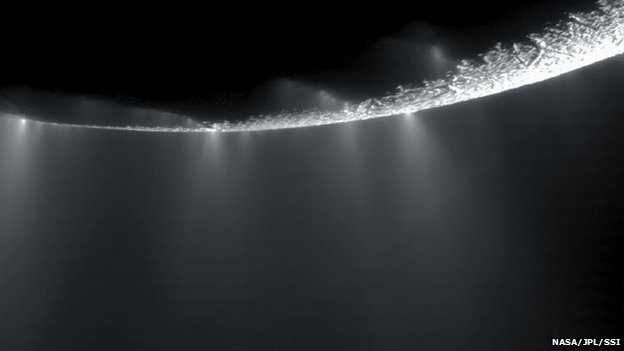Could Saturn's Enceladus harbour life?
Interview with
Saturn has a tiny moon called Enceladus, which is very mysterious: it's frozen solid on the surface, but has a warm internal ocean that periodically spurts plumes of ice particles out into space. Now researchers modelling the chemistry of these plumes have worked out what Enceladus is made of, and it has some intriguing opportunities for life. Planetary geologist David Rothery, from the Open University, has been taking a look at the results with Graihagh Jackson...
on the surface, but has a warm internal ocean that periodically spurts plumes of ice particles out into space. Now researchers modelling the chemistry of these plumes have worked out what Enceladus is made of, and it has some intriguing opportunities for life. Planetary geologist David Rothery, from the Open University, has been taking a look at the results with Graihagh Jackson...
David - What's in the paper is a series of experiments taking alkaline, saline water such as we think the internal ocean of Enceladus will be and letting it circulate through powdered rock samples. They tried it through carbonaceous chondrite material which is the most primitive form of meteorite and some other kinds of rock. Really, what the chemistry that was coming out into the water that had passed through carbonaceous chondrite was most similar to what's found in the plume. So, they're suggesting that the core of Enceladus is like a primitive meteoritic material. That means it hasn't melted and produced more evolved kinds of rocks.
Graihagh - Was there anything else interesting that this paper highlighted?
David - Well, the paper suggests that there should be quite a lot of molecular hydrogen. That's the H2 molecule produced. This is because of hydration reactions between the water and the rocky material. This is just dissolved hydrogen gas which should be in the water that's venting out of these hot vents on the floor of Enceladus's ocean. And because samples of the ocean are being sprayed out into space, we should be seeing H2 as well as the other things that we've already seen. This is going to be tested when we get the results of last Wednesday's flyby through the plumes by the Cassini probe because that passed at 49 kilometres above the surface of Enceladus, a really low flyby. The results when we get them in a week or two from Cassini show molecular hydrogen in these plumes as well, that will give us greater confidence in the results from this newly published study. And if there is hydrogen there, that's very exciting for people that are trying to look for habitats for life because if you've got hydrogen coming out of the hot vent then that's something that microbes can use to power their metabolism as they do on the floor of our own ocean.
Graihagh - That would be a pretty exciting discovery indeed.
David - It would. We're not going to find life. All we will do would be confirm a viable habitat for life.
Graihagh - So, in the next coming weeks, you might be able to confirm whether there's hydrogen there, but are we likely to know whether there's life anytime soon, perhaps in some future missions?
David - We do need a future mission - one that's got a mass spectrometer that will be able to measure and analyse large organic molecules of which there should be traces in the plumes. If there are microbes living on the floor of Enceladus's ocean, some will get caught up in this spray which is vented to space and we'll be able to study those.
Graihagh - So, we've got to sit tight for perhaps a decade for more. I feel like all the attention has really been on Mars when it comes to finding microbial life within our Solar System.
David - Yes. Rightly so, Mars is closer to us but to get at the life on Mars, you have to land at the surface which we can achieve. We know we can do that, but Enceladus, you don't have to land. You can fly through the plumes and if there's life there, you'll be flying through a spray of dead life. It's easier to collect at Enceladus. So, we shouldn't cease to look at Enceladus just because we're also looking at Mars.










Comments
Add a comment